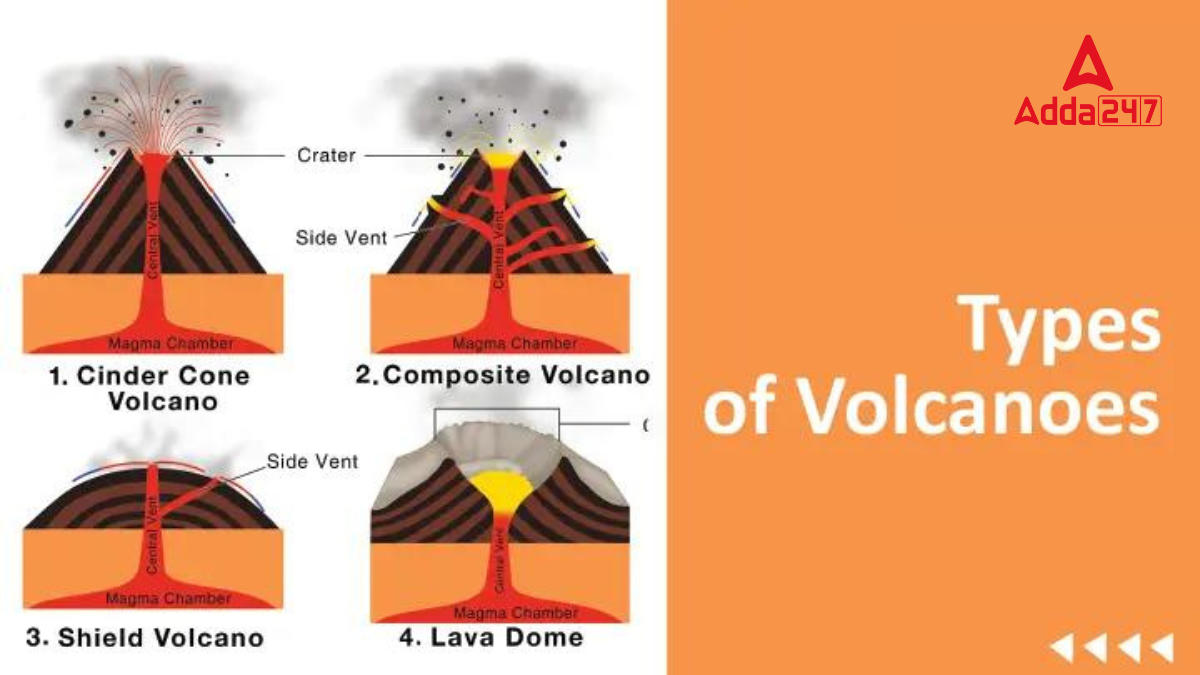Table of Contents
A volcano is a type of landform, specifically a mountain, where molten rock emerges from beneath the Earth’s surface. This volcanic mountain connects downwards to a reservoir of molten rock located beneath the Earth’s crust. When pressure within the Earth’s crust increases, eruptions occur. During these eruptions, gases, and rocks are forcefully expelled through the opening, either scattering lava fragments into the air or causing them to flow out.
What is a Volcano?
A volcano is a geological phenomenon occurring on the Earth’s surface, characterized by the eruption of hot lava, gases, and volcanic ash through the Earth’s crust. The term “volcano” is derived from the name of the Roman God of Fire, Vulcan. The Earth’s crust, divided into 17 solid tectonic plates, rests on an intensely hot and pliable layer in the Earth’s mantle. As a result, volcanoes are commonly situated in areas where tectonic plates are either moving apart (diverging) or coming together (converging).
Classification of Volcano
3 types of volcano: Volcanoes are classified as active, dormant, or extinct. Active volcanoes have a recent history of eruptions; they are likely to erupt again. Dormant volcanoes have not erupted for a very long time but may erupt at a future time. Extinct volcanoes are not expected to erupt in the future.
Why are there different types of Volcanoes?
- Viscosity is important in volcanic eruptions. A highly viscous magma produces steep-sided volcanoes, as the viscous volcanic material doesn’t flow that far from where it is erupted.
- A low viscous volcano, on the other hand, have gentle slopes as the more fluid lavas (basalt) can flow great distances away from the vent to produce broad, gentle slopes.
How many types of volcanoes are there?
Cinder cones
- Cinder cones are the simplest type of volcano.
- They are built from particles of lava ejected from a single vent.
- “Cinders” are small pieces of igneous rock that have been blown from the vent of a cinder cone
- As the gas-charged lava is blown violently into the air, it breaks into small fragments that solidify and fall as cinders around the vent to form a circular or oval cone.
- Because cinder cones are made up almost exclusively of loose fragments, they have very little strength. They can be eroded away easily, and relatively quickly.
- Most cinder cones have a bowl-shaped crater at the summit and rarely rise more than a thousand feet above their surroundings.
- Example: Cinder cones are numerous in western North America. Moreover, they can be found throughout other volcanic terrains of the world.
Shield volcano
- These are volcanoes that produce low viscosity, and where runny lava spreads far from the source and forms a volcano with gentle slopes.
- Most shield volcanoes are formed from fluid, basaltic lava flows.
- Example: Mauna Kea and Mauna Lo. They are the world’s largest active volcanoes, rising over 9 km above the sea floor around the island of Hawai’i.
Stratovolcano or composite volcanoes
- As compared to shield volcanoes, stratovolcanoes have relatively steeper sides and are more cone-shaped.
- They are formed from viscous, sticky lava that does not flow easily.
- The lava so formed thus builds up around the vent forming a volcano with steep sides.
- Stratovolcanoes are more likely to produce explosive eruptions due to gas building up in the viscous magma.
- Example: Andesite (named after the Andes Mountains), is perhaps the most common rock type of stratovolcanoes, however, stratovolcanoes also erupt a wide range of different rocks in different tectonic settings.
Caldera
- When a very large, explosive eruption occurs that empties the magma chamber, a place where magma is stored beneath a volcano, the roof of the magma chamber can collapse to form a depression or bowl with very steep walls on the surface.
- These are called calderas and can be tens of miles across.
- Calderas can also be formed during an eruption that removes the summit of a single stratovolcano.
- Caldera-forming eruptions can remove massive portions of a single stratovolcano.
Types of volcanic Eruption for UPSC
- When magma erupts as lava at the surface, it forms different types of volcanoes.
- These volcanoes depend on: the viscosity, or stickiness, of the magma; the amount of gas in the magma; the composition of the magma; the way in which the magma reaches the surface.



 TSPSC Group 1 Question Paper 2024, Downl...
TSPSC Group 1 Question Paper 2024, Downl...
 TSPSC Group 1 Answer key 2024 Out, Downl...
TSPSC Group 1 Answer key 2024 Out, Downl...
 UPSC Prelims 2024 Question Paper, Downlo...
UPSC Prelims 2024 Question Paper, Downlo...




